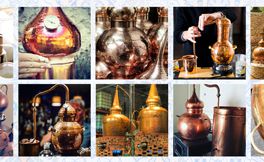Properties of Copper
Anti-corrosive
Copper is extremely resistant to corrosion especially the kind caused by contact with other metals and adverse weather conditions. Numerous copper artefacts have been unearthed from various archaeological spots, some dating back to ancient Egypt and Rome. That certainly attests to the anticorrosive properties of copper which have remained unchanged over time.
Malleable/Ductile
Normally the more tough and resilient a metal, the less malleable it is. Copper is an exception to the rule – it is resilient, malleable and ductile. This means it can easily be pounded, stretched and shaped. These properties make it extremely suitable for the construction of alembics especially those with a peculiar design.
Anti-microbial
The use and the benefic properties of copper are widely documented. The Romans used copper to improve public health long before micro-organisms were identified as a possible cause of disease and sickness. They used it in their plumbing and recognised that copper cooking utensils helped prevent illness. Copper tubing is still widely used in plumbing because it can help preserve the purity of drinking water. Copper has antimicrobial effects that can inhibit water-borne micro organisms, such as bacteria, viruses, algae, and infectious parasites in the drinking water supply. These properties are recognised by the scientific community.
Recent research conducted by microbiology researchers Professor Bill Keevil and Dr Jonathan Noyce at the University of Southampton has confirmed the antimicrobial properties of copper. It was found that the Influenza A virus, a strain similar to the avian flu virus, is virtually eradicated within six hours on copper surfaces. Stainless steel on the other hand, still harboured a considerable number of viruses after 24 hours.
Professor Keevil, who heads up the School’s Microbiology research group, explained: ‘The findings are so pertinent to the current concerns about containing a potential outbreak of the avian flu strain, that we felt it important to provide some of the preliminary results at this time.’
These results are ‘consistent with the demonstrated antimicrobial effects of copper cited in published studies on E. coli O157:H7, Methicillin-Resistant Staphylococcus aureus (the superbug, MRSA) and Listeria,’ said Professor Keevil. These studies, also conducted by Professor Bill Keevil’s research team, found that the Escherichia coli O157 strain, an especially lethal strain of the E. coli bacterium, dies after 4 hours on a copper surface, even under dry conditions, while it survived for 34 days on stainless steel.
The use of copper is also considered crucial in preventing the spread of infections in public facilities such as hospitals. Suggesting it would be worthwhile to consider using uncoated copper or high-copper alloys, such as many brasses and bronzes, for common-touch surfaces to help minimise cross-contamination, Professor Keevil said: ‘Door knobs and handles, push plates, countertops, sinks and other frequently-touched hardware in healthcare and other public facilities are prime candidates for use of copper alloys to help control the spread of infection.’
Copper is found naturally in the food we eat, the water we drink and the air we breathe. It is considered essential to the human body and is necessary for the absorption of iron. It is also used in the preparation of antibiotics to keep them pure. Microbial food poisoning can be reduced by using a copper surface when preparing food.
Material of choice for the discerning distiller
Since the dawn of distillation history copper has been used for the construction of stills. Both scotch whisky and bourbon whiskey distillers swear by it and would never consider replacing their beloved copper stills with stainless steel ones.
Pot stills are traditionally made of copper for a number of practical reasons:
Copper absorbs sulphur containing compounds and yeast cells which are produced during fermentation the presence of which is undesirable in the distilled spirit or essential oil. Sulphur compounds and yeast cells smell.
Copper keeps the distillate sweet.
Copper reduces bacterial contamination.
Copper has excellent heat transfer properties, which helps in distributing heat evenly and in cooling the vapours.
Copper prevents the production of ethyl carbonate which is a toxic substance formed from cyanides (cyanides are found in high concentration in fruits containing pit).
Copper also improves the quality of the final product. If the quality of the mash is not microbiologically perfect, copper will improve the aroma of the final product.
Certified material test report:


